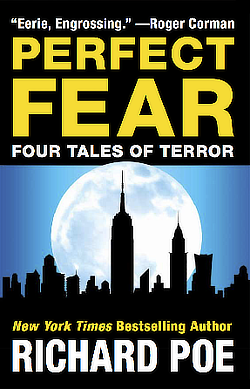PERFECT FEAR: Foreword
by Nina Zivancevic
Reprinted from Perfect Fear (released by Heraklid Books, July 5, 2012)
PERFECT Fear is a collection of fantastic tales, exploring the darkest limits of fear, madness and cruelty. It would be easy to classify these stories as “horror” fiction. Those readers who desire nothing more than a good scare will find ample satisfaction in these pages. But those who look deeper, will gain more lasting rewards.
Many will be surprised that Richard Poe has written such a fanciful work. He is best known for serious, non-fiction books treating of such worldly topics as history, science, business and politics. Now Poe leads us unexpectedly into a very different sort of world. He introduces us to his inner demons, inviting us to descend with him into his own private Dante’s Inferno. Those familiar with Poe’s previous work may wonder what has gotten into him. What has happened to this sober-minded journalist and business writer? What strange mood has possessed him? Having known this author for more than thirty years, I am not so surprised.
|
ZIVANCEVIC: “Many will be surprised that Richard Poe has written such a fanciful work. He is best known for serious, non-fiction books… Now Poe… introduces us to his inner demons…” |
|
When I first met Richard Poe, he was studying to be a poet. We met in 1981, at Naropa Institute in Boulder, Colorado. That summer, I arrived from the former Yugoslavia, with my colleague Ivana Milankov, to work with Allen Ginsberg on the first Serbian-language edition of Beat Generation poetry. Poe was working closely with Ginsberg that summer, as a writing apprentice.
I was a little surprised when Poe later abandoned his literary pursuits in favor of a more conventional career in journalism. No doubt, this was a sensible and practical decision, but it came at a cost. Poe had to suppress a large part of himself. I often wondered when his explosive imagination would finally burst forth. Poe’s new book, Perfect Fear, brings the long-anticipated detonation. It is a collection of four stories, including the novella or novelette “Scotophobia,” and three shorter works, “The Strange, White Room,” “Don’t Come Back, Mommy” and “The She-Wasp.” All are unified by a single, thematic thread; an examination of human fear. On the surface, the stories in Perfect Fear employ all the standard elements of horror fiction, such as those we find in the works of Kafka or Edgar Allan Poe. But there is much more to these stories than horror.
|
ZIVANCEVIC: “One does not need to be a certified psychologist, psychiatrist or psychoanalyst to understand these stories and to feel their full impact on the psyche (although Poe’s work does invite a certain knowledge in these domains).” |
|
As we read, all sorts of dream-like events dance and slide before our eyes. Each story moves with cinematographic speed and gusto, puzzling us with its strange aura of the inhuman, the unnatural and the supranatural. At the same time, we are deeply aware that this author is trying to tell us something more. There is a profoundly human story lying buried beneath the supernatural veneer. One does not need to be a certified psychologist, psychiatrist or psychoanalyst to understand these stories and to feel their full impact on the psyche (although Poe’s work does invite a certain knowledge in these domains). Any reader with an interest in human nature and the human condition will find much in Perfect Fear that is engaging and thought-provoking.
On one level, “Scotophobia” could be read as a perfect metaphor of urban life in a megalopolis such as New York City. The story opens with a simple, almost clinical, statement which would fit nicely in some textbook of psychology or sociology: “Every New Yorker has his own idea of what ‘the worst’ might be.” In this particular study of a New Yorker’s fears and anxieties, we move quickly from the clinical to the extraordinary. We encounter bugs which are not really bugs, alligators which are not exactly alligators, and people who are definitely not people.
The hero and heroine of this story — Frank and Miranda — also undergo some strange metamorphoses. At times, the cartoon-like action seems to transport us into a comic-book world, where the unassuming Frank mutates from a Clark Kent into a Superman, and his wife Miranda becomes a sort of Catwoman who sees in the dark. On another level, we could read “Scotophobia” as a retelling of the myth of Orpheus and Euridice, who were told they could escape from Hell, but only on one condition; that Orpheus not look back. Being human, Orpheus could not resist looking back. Frank and Miranda also look back in “Scotophobia,” and what they see is fear and darkness or, more precisely, the fear of darkness, that universal condition from which every psychoanalyst tries to rescue his patients.
Greek mythology makes a much more explicit appearance in the story “Don’t Come Back, Mommy,” in which the superstitions and folk beliefs of an old Greek woman provide the only sense of order in a chaotic world driven by greed, jealousy and misunderstanding. Here a child, little Martin, faces a ghost of his own mother, turned into a sea-monster in the dark night of the Montauk beach resort. His American culture provides no context for understanding such a horror, and no method of fighting it, but his old Greek nanny knows what to do. Despite all the Gothic elements in this story, which include wicked winds gusting through windows, as well as abundant outpourings of blood and other ghoulish excretions, it is hard for us not to read this story as a dream experience or even a moral fable about growing up and reaching for the necessary independence we must all gain from our parents.
If we were to look for the real hero of Richard Poe’s stories, it would be the same in all four tales. It is not a particular character, but rather an ethereal entity which has been called the “background of the human mind” and sometimes the psyche, but which the author of Perfect Fear chooses to call the “soul.” Poe’s intense interest in the soul recalls Dostoyevsky, but it is an interest rarely found in contemporary fiction. True, certain authors of science and horror fiction, such as William Gibson and others, have attempted to address the problem of the so-called vanishing of the human soul in the age of technology and extreme industrialization. However, there is an important element in Richard Poe’s fiction which I don’t find in other works of this kind, and that is humor, a powerful tool which liberates his characters from the mundane and superficial approach which we often find in this literary genre.
Poe’s macabre sense of humor reaches its height (or perhaps depth) of hilarity in “The Strange, White Room,” in which Norton Zachary solves an important scientific problem, only to learn that he has created a much worse problem for himself. “The Strange, White Room” reminds us, in some ways, of Mary Shelley’s Frankenstein. Where Dr. Frankenstein created a living corpse from human body parts, Zachary creates “avatars” or copies of human beings, from bits and bytes on a computer. The technology has changed, but the problem remains the same. Like Frankenstein’s monster, Zachary’s avatars cannot become fully human until they lose their innocence. They must descend into darkness. Norton Zachary makes that descent. His longing to return to his own body provides an amusing leitmotif to this story, which echoes the poet Allen Ginsberg and his line, “I always wanted to return to the body where I was born.” The author of Perfect Fear, who studied with Ginsberg, surely knows this line all too well. If indeed the leitmotif of this story is the “eternal return” to the womb, then the subliminal theme of “The Strange, White Room” must be the quest for love.
Love and obsession are also the themes of Poe’s fourth and final story, “The She-Wasp,” a bitterly funny fiction whose exotic setting, a doomed riverboat steaming up the Amazon, mimics the “jungle” adventures of the colonial past in a 21st-century context. In this tongue-in-cheek salute to Conrad’s Heart of Darkness, two Englishmen far from home surrender to the darker sides of their nature, until at last they are drawn into the very darkest experience Nature has to offer.
“The She-Wasp” provides an appropriate finale to Perfect Fear, powerfully reiterating the themes which inform all four of these stories. The heroes of Poe’s tales are really Everyman and his fellow sufferers, each falling prey to his own fears and obsessions. For each character, the consequences prove terrible, yet the author’s humor provides a benevolent voice throughout, gently reminding and teaching us that, no matter what catastrophes and degradations we humans bring upon ourselves, it is only the physical or bodily part of us which suffers, while another part, more lasting and durable, retains its nobility.
Nina Zivancevic
Paris, France
________________________________________________
Nina Zivancevic is a poet, novelist, essayist, art critic and literary scholar. Her numerous books include Death of New York City and Inside & Out of Byzantium. A native of the former Yugoslavia, Zivancevic spent many years in the United States. She was a close associate of the poet Allen Ginsberg, collaborating on the first translation of his works into Serbian, and serving as Ginsberg’s teaching assistant at Naropa Institute. Zivancevic was a noted figure in the East Village poetry and performance art scenes of the 1980s. Today she lives in France and teaches the history of the American avant-garde at the University of Paris.
Reprinted from Perfect Fear (released by Heraklid Books, July 5, 2012)









